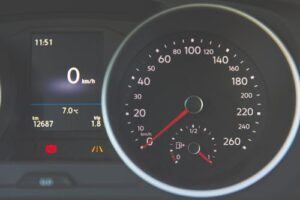
First, what is TPMS
A tire-pressure sensor is a small programmable electronic device, located in the pressurized pocket made by a wheel and tire that constantly measures the air pressure inside the tire.
The sensor transmits that information via low-frequency radio to the vehicle’s on board computer and, if the car has one, to a corresponding display in the instrument cluster.
It reads out in pounds per square inch (psi), and it illuminates an amber warning light to alert you if one or more tires are low on air. The sensor, which looks like a small cylinder, is an electrical component which you can find inside the tire tightly attached to the inner part of the rim.
Tire-pressure sensors are usually attached to the valve-stem assembly of each tire and are powered by batteries. In this article you will learn how to reset TPMS sensor but first we will answer some of your frequently asked questions.
There are two types of TPMS, the direct and the indirect type. The direct TPMS are located in the tire pressure valve, which acts as an antenna, or are wrapped around the rim of the wheel with a band clamp while the indirect types are located within the ABS braking system or the speed sensors of each wheel.
What Function Does It Perform?
The sensor warns about the pressure of the tire most especially when it is low. In the event that the sensor detects that air pressure in a tire has dropped to a dangerously low level (25{2e1e219470849bf7ec91275b0a9fbc84b08096e911ffdb617f5afdb5ab7ea907} below the recommended standard air pressure), a warning message or light will display in the instrument cluster.
For How Long Can a TPMS Live?
The estimated life expectancy of an OE TPMS sensor is 5 to 12 years, with the average lifespan being 7 years. Its life span is directly related to the number of radio frequency transmissions the sensors make.
How Long Does It Take To Reset TPMS Sensor?
It should be within an average of 20 – to – 30 – minutes. To reset the system, first make sure the tire pressures are correct. Turn the engine on(without starting the car), then press and hold the reset button until the light blinks three times before releasing it.
Thereafter, you can start the car and let it run for about 20 to 30 minutes before resetting the sensor. You will usually find the tire pressure monitor reset button beneath the steering wheel.
Do TPMS Have To Be Programmed?
Some Sensors come programmed (cloned) already by the manufacturers while some (Programmable or universal) are to be programmed when installing them on the new tires.
Whichever way, when programming, appropriate protocol and application information of the vehicle must be considered before they can be properly installed in the tire. They must also be re-learned to the vehicle to ensure proper functioning.
How Do I Program TPMS?
When fixing new tires on your vehicle it is necessary to program or reprogram the TPMS. To program it, turn on the ignition without putting the car engine on.
Press and hold the keyless-entry fob transmitter’s LOCK and UNLOCK buttons, at the same time, for about five seconds to start the TPMS learn mode. The horn will sound twice to indicate that the TPMS receiver is ready and in learn mode.
How Much Does It Cost to Replace TPMS?
With about $50 -$100 for a set of four, you can have your TPMS replace at a repair facility or tire store depending on type of vehicle you drive.
When Best Do I replace a Bad TPMS?
If the battery in one or more of your TPMS sensors is malfunctioning or depleted, we recommend contacting a local TPMS service technician or dealership to carry out an inspection.
The technician can then assess the status of the TPMS sensor by using a properly formatted TPMS scan tool and recommend next step or have it changed.
Do I Need to Replace TPMS When Replacing My Tires?
It depends on the age of the sensors because by the time the tires are worn out, the TPMS sensors may be nearing the end of their useful service life, or they may not have enough remaining battery life to last another set of tires.
In most cases, the battery is molded into the TPMS sensor assembly so it cannot be replaced separately. Therefore, for proper functioning and safety, it is recommended that both the tires and sensor are to be replaced together.
What Does Replacing My TPMS Involve?
When you have your vehicle diagnosed and it is discovered that your TPMS battery needs to be replaced, there is the need to replace the entire assembly, not just the battery because the battery is an integral part of the sensor which cannot be singled out.
Therefore, since they both have about the same lifespan, it makes sense to have them all replaced at once rather than making several trips to the technician repeatedly. Replacing your TPMS therefore implies having assurance of safety whenever you ride in your car to any destination.
What Can Cause Damage(s) to My TPMS?
TPMS is prone to many hazards. Damages can be caused by flattering battery, flat tires, accidents, pot holes etc. It may suffer corrosion due to road salt or unfavorable weather condition.
The failure of the tire pressure sensor can have several causes, particularly heat. The location of the tire pressure sensor means that a lot of heat is generated around it.
Heat can easily damage an electronic component, especially if it is small. Secondly, dirt and dust can prove damaging to the tire pressure sensor.
Pollutants such as dirt and dust creep into the tire and cause damage to the tire pressure sensor. Perhaps the most significant and probably the rarest reason for a tire pressure sensor failure is water.
Normally we don’t drive our cars on water, but puddles of water on the road, which are deposited after heavy rainfall, can be a danger to the tire pressure sensor.
Water can cause a short circuit, which can completely destroy the tire pressure sensor. A defective sensor should either be repaired or replaced, depending on its current condition. If it is too worn, it is better to replace it, as replacement is not very expensive.
How Best To protect My TPMS?
To protect your TPMS, you have to avoid road hazards such as potholes and curbs. You need to keep your car battery charged and well maintained, keep your tires well inflated and maintained to ensure a long life for its components.
Driving habits greatly influence the number of RF transmissions a sensor makes in its lifetime. Sensors usually transmit when the vehicle is stopped and transmit more often when in motion so maintaining a constant speed, such as when you’re on a highway, reduces the demand on TPMS sensors and allow the sensors to transmit less often.
Drivers who often drive in start-and-stop type of traffic will have a greater impact on the vehicles tire pressure monitoring sensors.
Weather can also have an impact on tire pressure sensor battery life. Cold conditions allow batteries to last longer. Warmer conditions take more of a toll on TPMS battery life.
How Do I Care For My TPMS?
Always inspect and clean the tire pressure sensor with alcohol or any recommended spray cleaner. Air-fill the tires appropriately and reset the TPMS as often as you fill in air.
How Do I Repair or Replace the Tire Pressure Sensor?
Because of its easy positioning, you can replace the sensor without the need for a mechanic.
However, consider the following tips on how you can try to replace a tire pressure sensor by yourself:
- Gather the necessary equipment for removing the tire from the rim
- Remove the tire from the car and place it on one side
- Using two levers, separate the tire from the wheel rim
- Locate the tire pressure sensor on the rim
- Remove the connectors from the tire pressure sensor
- Use a screwdriver to unscrew the sensor from the wheel rim and place it somewhere safe
- If the sensor looks dirty and worn out you could clean it and place it back again
- If the sensor looks in bad condition you need a replacement
- Clean the inside of the rim with an alcohol solution, especially in the sensor’s location
- Match the new sensor with the old one and put it safely in its place
- Screw the sensor and place the electric connectors to it
- Install the rubber tire back on the rim and attach the tire to the car
- Test the sensor after adding air to the tires
- Reset the tire pressure sensor using the settings found in your car’s manual
- Drive the car around and check if the sensor blinks again
Conclusion
Tire Pressure Monitoring Sensor is an essential part of your safety mechanism that needed to be carefully studied, understood how it works and properly maintained. Our above tips on how to reset TPMS sensor and relevant FAQ’s, if taken seriously will serve as useful guides.
Remember, you can continue to drive indefinitely with a failed TPMS sensor in one or more of the wheels, but then the system will never be able to warn you if you’ve picked up a puncture in those tires and are on the verge of a blowout.
If you have any comment or question leave it in the box below, we will be glad to hear from you.


